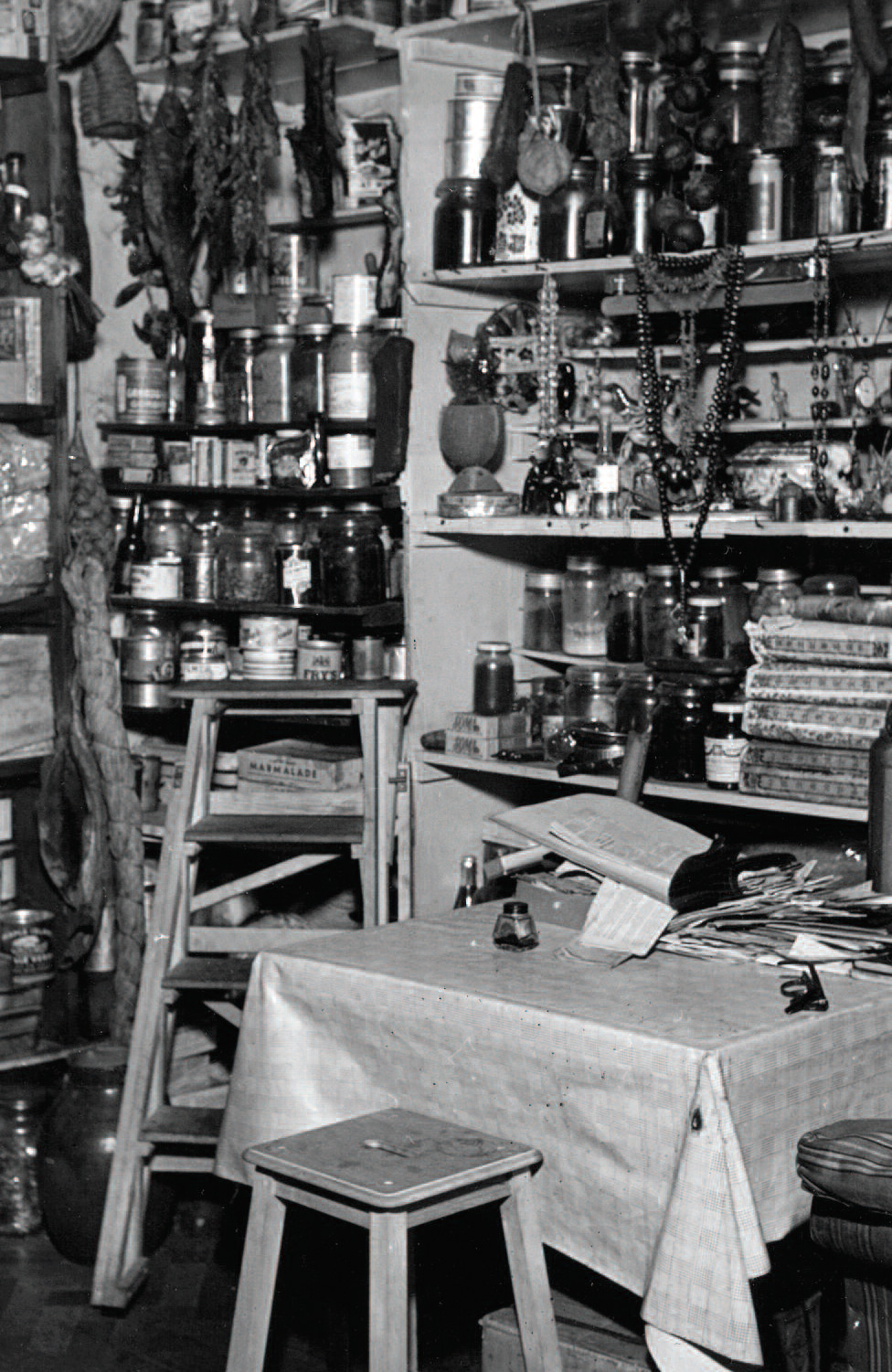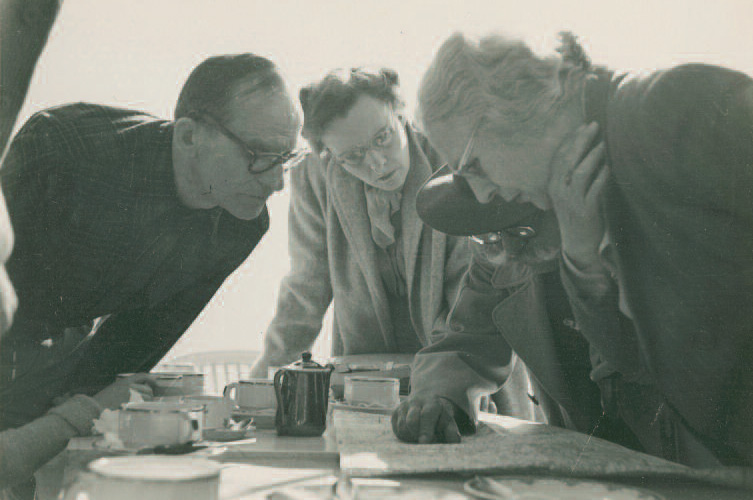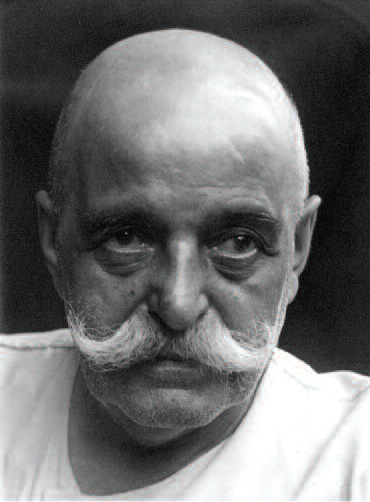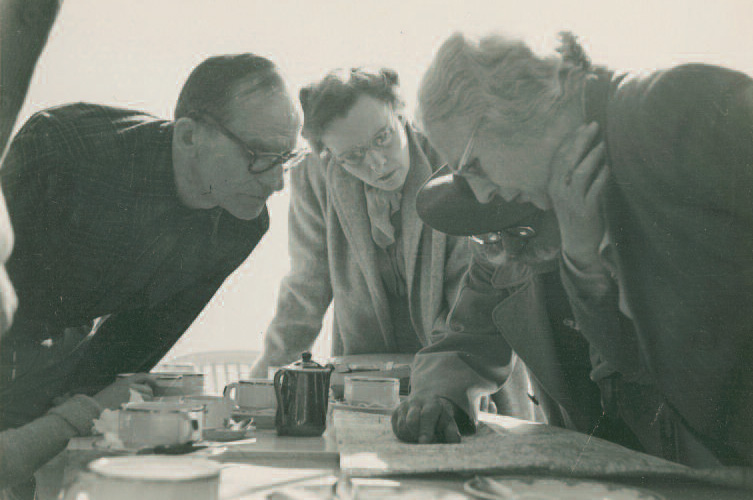
A place apart, even a time apart….
Wagram 53-46. Should you need to call, this was Gurdjieff’s telephone number on the rue des Colonels Renard in Paris, where he lived from autumn 1937 to the end of his life. Nearly anything from that place and time, even this obsolete code, evokes nostalgia in those, decades later, who acknowledge Gurdjieff—nostalgia leaping over the fact that we didn’t know him to settle among the pupils, friends, and family who did know him. Surely there are one or two places left in the salon, or room to stand if not sit around the table in the next room. We might be needed in the chain of people silently passing plates of food—that was the custom—from the kitchen to forty or fifty others crowded into dining room, salon, foyer. Oxygen is already long since exhausted, but that doesn’t seem to matter. Gurdjieff rarely if ever opened the shutters, windows, or curtains: his flat was a place apart, even a time apart. Somehow everyone is all right. So, too, Gurdjieff. He is at home and well.
The rue des Colonels Renard is centrally located. Today you might want to stop in a café at the intersection of avenue Mac-Mahon and the rue des Acacias, where Gurdjieff often had his coffee and surely looked from time to time past a receding row of street lamps toward a flank of the Arc de Triomphe not far off. At some point he turned that view into a parable about the distant aim toward which one might well be toiling and the many smaller aims and thresholds, requiring meticulous attention, that precede it. His apartment was nearby in a street like any other. Yet it was là-bas, as one of his pupils put it—there yet far off, another world. “Here in my house,” Gurdjieff stipulated, “all must be quintessence. Rest you do at home.” There was a further rule, captured by another of his pupils: “Here there are no spectators.”
To visit the apartment today, soon seventy years after Gurdjieff lived there, is like entering a sepia-toned photograph: some objects in ceramic and glass retain vivid color, but much has coalesced toward warm uniformity, not displeasing but settled, as if timed by a slow clock. The apartment isn’t large—it has long seemed a miracle that fifty or more could join Gurdjieff there. Foyer, salon, dining room, modest kitchen with back door, two bedrooms down a hall, and the pantry or “office” where Gurdjieff met pupils for private conversations, often over coffee, sometimes with his harmonium nearby for music. What strikes everyone who visits, then and now, is the collection of framed paintings thickly lining nearly all walls from wainscot to ceiling, in the manner of nineteenth-century museums. Why did Gurdjieff possess and display a vast collection of paintings of indifferent quality, ranging in theme from landscape and still life to sacred Christian subjects and the occasional nude or Modernist abstraction? We can ask Fritz Peters to respond to the question. After military service in the Second World War, Peters found his way to Gurdjieff in a state of greatest need.
When I arrived in Paris again, I telephoned Mr. Gurdjieff and he made an appointment to meet me at a café later that morning. After we had met and while we were drinking coffee, we were approached by an elderly woman who proceeded to have a long conversation with Mr. Gurdjieff in Russian. I understood enough of their conversation to gather that it was primarily concerned with problems of health, finance, and the difficulty of obtaining sufficient food in Paris at that time. The black market, I knew, was flourishing, and while food was available, it was tremendously expensive. At the conclusion of the conversation, the woman opened a package, wrapped in newspaper, and held up a small oil painting for us to look at. Mr. Gurdjieff asked her various questions about it: when she had painted it, and so forth, and finally bought it from her for several thousand francs. She thanked him effusively and I gathered that, thanks to his purchase, she would be able to afford to eat for a few more days.1
From one perspective, the art collection—considered by some connoisseurs to be the worst art collection in the world—was pure philanthropy. Rather than humiliate indigent older people, mostly Russian exiles, by giving them charity outright, he had built a reputation as an art collector always interested to see their own paintings or works in their possession. From a second perspective, which reached me through oral tradition, he considered his art collection to be one part of a domestic diorama illustrating the idiocy and grandeur of the human race; it was a collective symbol. On occasion he improvised about it. J. G. Bennett has written that once in the late evening when few stayed behind “he boasted of all the pictures, their amazing age (plus de 4500 ans! for a poor copy of a Dutch painting), the enormous prices he paid—how they were all stolen out of museums which are left only with copies, etc.”2 Gurdjieff relaxing after a rigorous session with his pupils is unmistakable.
The difficulty of observing details in the apartment is that “here there are no spectators”—true to this day. No one is there as a tourist. It remains a meeting place, though I have noticed alongside my own discreet discomfort, as I have tried to scan and remember details, the discreet discomfort of others similarly interested. Details matter because Gurdjieff constructed a symbolic world from the paintings throughout the apartment and, in the salon, from hundreds of small objects which sum to a statement about the variety of humankind and the tiers of reality—all the while retaining a certain coziness, the well-used quality of the home of an older person.

As far as I know, only one space has been renovated since Gurdjieff’s day: the pantry or “office” has become a library. We know its original condition from a handful of photographs and descriptions. Dr. Kenneth Walker, a distinguished British surgeon and author, found his way to Gurdjieff’s apartment after World War II. His books Venture with Ideas and A Study of Gurdjieff’s Teaching are among the keenest in the literature. Walker was resolutely free and “simple honorable,” as Gurdjieff would sometimes define a value he cared for, in his regard for Gurdjieff, the teaching, and the company he joined at the rue des Colonels Renard.3 For some reason the doctors closest to Gurdjieff in the later years—among others, the cardiologist William Welch in New York, the internist Bernard Courtenay-Mayers in London, and the leading urologist Pierre Aboulker in Paris—shared that characteristic with Kenneth Walker. I admire this; it offers a model for a future in which the Gurdjieff teaching is understood as a cogent inspiration for lives of service. Walker has written:
Beneath the daily routine of the rue des Colonels Renard there ran a strong current of purpose, a current which would every now and then break through to the surface and reveal itself. This was particularly likely to happen when two or three of us were invited to take coffee with Mr. Gurdjieff in his own private room. This sanctum was situated in the very heart of his flat and it was actually the storeroom from which emanated the odor of spices which always pervaded the hall. The walls of his room were traversed by tiers and tiers of wooden shelves, all overladen with every conceivable form of grocery: innumerable cans; boxes of candy; bags of flour and sugar; packages of oatmeal, currants, and raisins; bottles of brandy and vodka…. At a small table, pressed up against a rampart of shelves mounting up to the ceiling, sits Gurdjieff, with a large chocolate fish, covered with shining tinfoil paper, swinging just above the level of his immense head. Madame S. is seated there at his side ready to interpret for us difficult passages in his mixture of French, English, and Russian, while the rest of us sit around him on small canvas-topped stools or upturned grocery boxes. Lise has deposited the tray of coffee bowls on the table…. It is an occasion either for music or for a private talk, and we sit there sipping our coffee—the sugar must always be kept in the mouth and never be put into the bowl—and listening to his music or else to his words.4
A code of discretion applied. “If we had been invited to Gurdjieff’s sanctum not for music but for a talk,” Walker continued,
the conversation was always of a very private nature. “This that I tell you,” he would say, “is for you alone and it must not be discussed with other people. I ask you to do this and then later, when you come next time to Paris, you can report to me what you find.” He would then outline some psychological or physiological exercise and would give us very precise instructions on how this exercise was to be carried out. While imparting these instructions he would speak with the exactitude of an old and experienced physician prescribing treatment to his patients, choosing his words very carefully and talking in grave and convincing tones.5
The pantry can be understood in two ways. It was Prospero’s cave, the intimate place where roots and leaves and foods from the world over gave comfort and a due setting for the old magician, a “colleague of life,” as Gurdjieff once named himself.6 And it was a symbolic representation of all and everything—precisely as he had entitled his trilogy of writings. This being said, we should also keep in mind an observation by Rina Hands, a British pupil who later founded a group for the study of Gurdjieff’s teaching in Australia. “I know, of course,” she wrote, “that everything that takes place here may be said to have layers and layers of meaning and that if Mr. Gurdjieff asks you to pass the salt, even that may have a special significance for you, but it also means he wants you to pass the salt.” In that light, the pantry was a pantry, but also “all and everything.”
The salon at rue des Colonels Renard, where meetings and readings took place, and where the overflow of people sharing in lunch or dinner could find a spot, has its full complement of paintings and two remarkable assemblages—a neutral word for things not neutral at all. The first of these is a tall glass cabinet with glass shelves populated by innumerable porcelain figurines again representing all and everything, in this instance the all and everything of human being. Shepherds and farmers, dancers and merchants, dervishes and monks, villagers and courtiers—as cheerful as can be. Owing to their miniature size, one has the impression of seeing them from great height, as if perceived by Gurdjieff’s literary hero, the reformed and wise Beelzebub, who typically studies us by telescope from afar. It must have taken Gurdjieff considerable time to assemble this immense though miniature cast of characters, surely as much for his own delight as for the instruction of pupils. It’s good to have something to shop for as you make your way through a city.

There was a second assemblage in a back corner of the salon, this one nearly defying description. Due to the sound rule prohibiting spectators, there is scarcely ever a moment to assess and memorize it. My description, like Kenneth Walker’s in Gurdjieff’s lifetime, is subject to error. Walker: “The opposite corner of the room was occupied by a large structure of mirrors and gilt, a piece of furniture which a child would have adored. Everywhere on its many platforms of mirror could be seen gay little figures, men and women being drawn along in droskies, mounted soldiers, galloping Arab sheiks, Nubians on camels, dancing ballerinas, everything that one could wish to find and still more to be discovered…. If the wires were plugged in and the current switched on it would sparkle with dozens of tiny lights…. I had no time to examine anything more in the room.”8 Let’s try again: imagine an enormous chandelier flowing from ceiling to floor; imagine strings of sparkling crystals falling past a sequence of progressively larger mirrored platforms on which tiny figures are dynamically living their lives—doing all of the things we do, but smaller.
The crèche of humanity: such all of this was and is. Such tenderness for humanity, for what we are in our first innocence. There is no reason to believe that Gurdjieff had it in mind, but my thoughts go to Proverbs 8, where Wisdom comes before God, “rejoicing in His inhabited world, and my delight was with the sons of men.” There is more still in the salon, but enough has been said to summon something of the unique interior world where Gurdjieff in his last decade offered a new statement of his teaching and resolutely embodied it—for it was never just words.♦
Excerpted from Gurdjieff Reconsidered: The Life, the Teachings, the Legacy (Shambhala Publications, Boulder, February 2019)
Notes
1 Fritz Peters, Gurdjieff Remembered (London: V. Gollancz, 1965), 107.
2 John G. Bennett and Elizabeth Bennett, Idiots in Paris (Gloucestshire, UK: Coombe Springs Press, 1980). 32.
3 A.L. Staveley, Memories of Gurdjieff (Aurora, Oregon: Two Rivers Press, 1978). 72.
4 Kenneth Walker, Venture with Ideas: Meetings with Gurdjieff and Ouspensky (New York: Pellegrini and Cudahy, 1952), 168.
5 Walker, Venture with Ideas, 170.
6 Solita Solano, Unedited notes, January 24, 1936.
7 Rina Hands, Diary of Madame Egout Pour Sweet (Aurora, Oregon: Two Rivers Press, 1991). 50.
8 Walker, Venture with Ideas, 155.
From Parabola Volume 43, No. 4, “Hope,” Winter 2018-2019. This issue is available to purchase here. If you have enjoyed this piece, consider subscribing.
